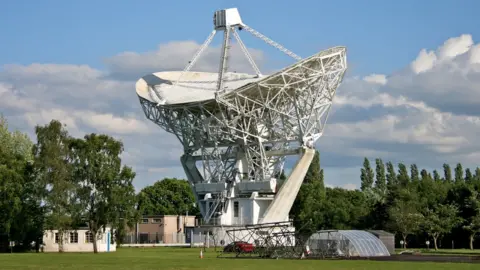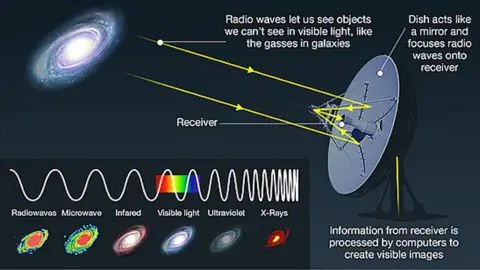Jodrell Bank's Mark II telescope gets Grade I listed status
 Mike Peel/University of Manchester
Mike Peel/University of ManchesterJodrell Bank's second largest radio telescope has been given Grade I listed status for its pioneering role in radio astronomy.
The 38m (124.6ft) Mark II radio telescope is the smaller of the two large dishes at the observatory site.
The Lovell telescope, the other dish originally known as Mark I, was given the same status in 1988.
Historic England said the listing celebrated the Cheshire observatory's history and its impact on the world.
'Remarkable place'
Other buildings and structures at the site that played a pioneering role in the early days of radio astronomy have also been recognised.
Four buildings and part of a converted ex-army radar antenna, known as the Searchlight Aerial, have been given Grade II listing.
They include the Park Royal building, the Electrical Workshop, the Link Hut and the Control Building.
 PA
PAJodrell Bank Observatory dates from the start of radio astronomy soon after World War Two.
It was pivotal to developing the new science, which involves capturing light at invisible radio wavelengths to "see" celestial objects that would otherwise be hidden.
The site was bought by the University of Manchester in 1939 and was first used for radio astronomy in 1945 by Sir Bernard Lovell and his team.
The Mark II telescope was built between 1962-64 to the specifications of a design developed jointly by Sir Bernard and structural engineer Charles Husband.

What is radio astronomy?

- Radio astronomy is the observation of radio waves that are emitted from celestial bodies, such as distant galaxies or stars
- Many strong sources of radio waves are invisible in normal light, so looking at radio waves reveals a completely different picture of the universe
- Radio waves are better at travelling long distances than shorter wavelengths, so can provide a clearer "view" of very distant objects than can be gathered using normal light
- Though the information gathered by radio telescopes is not in a visible form, it can be processed by computers to create images
Source: BBC Science

Crispin Edwards, listing adviser at Historic England, said: "Jodrell Bank is a remarkable place where globally important discoveries were made that transformed radio astronomy and our understanding of the universe.
"We are celebrating the history of the site and its impact on the world by increasing its recognition on the National Heritage List for England."
Prof Teresa Anderson, director of the Jodrell Bank Discovery Centre, said: "Science is a hugely important part of our cultural heritage and we are very pleased to see that recognised, and protected, with these new designations."
